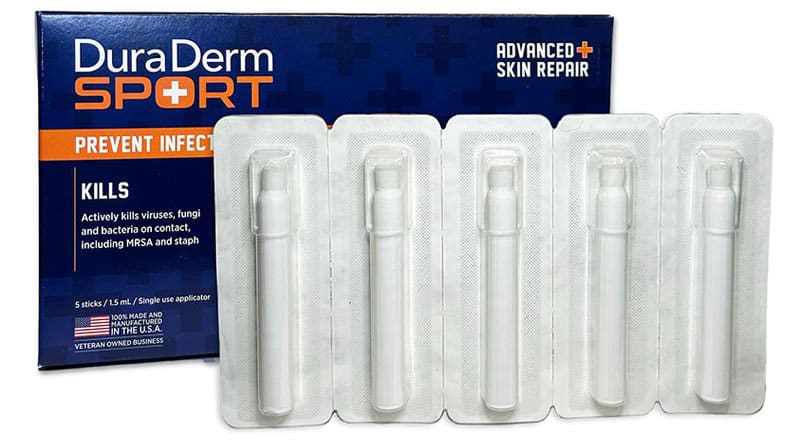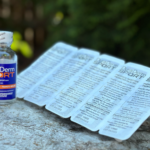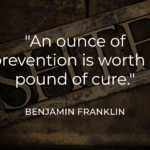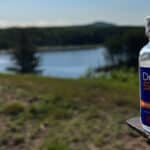
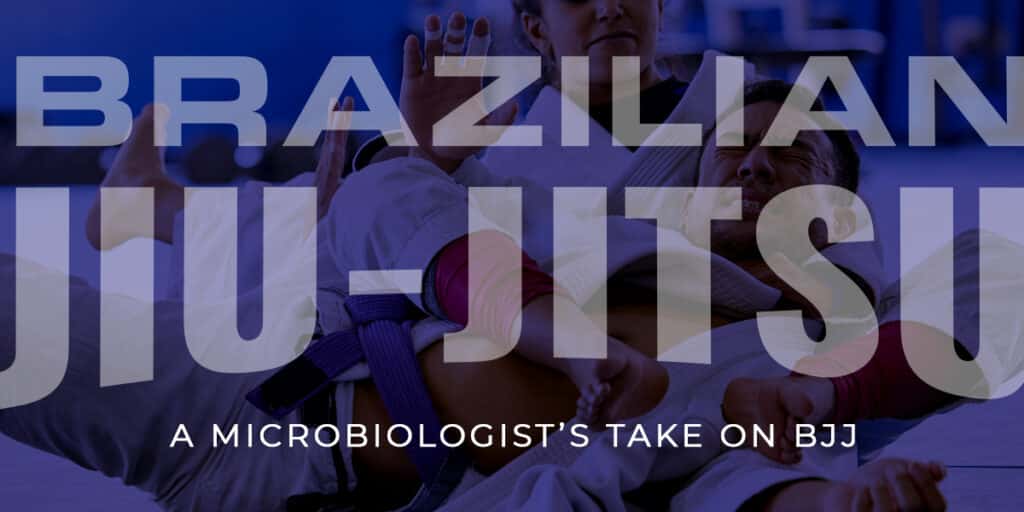
Have you ever read something and felt “I totally should have written this”, well for us at DuraDerm SPORT the article below is one of those pieces. We have published it in the original form and provided the link to the original article.
The part that most excites us, is that DuraDerm SPORT is a solution to the skin conditions and irritations that so many Brazilian Jiu-Jitsu, and other athletes, experience.
Originally published: http://bjiujitsu.blogspot.com/2011/09/microbiologists-take-on-bjj.html
So I’ve really been wondering about all this…information we’ve got floating around regarding treatment, prevention, cleanliness, the whole shebang. Thankfully, a girl I know from WAY back grew up to be a really cool microbiologist (she managed to work a reference to LeBron James into a conversation about bacteria) and she was nice enough to, after a weekend at Dragoncon, take the time to answer some questions I’d collected.
If you have a few minutes, take the time to read the whole thing. She addresses the general “lifestyles” of bacteria and fungi, the use of triclosan, MRSA, and general habits that we have around keeping clean in the gym, not to mention a bunch of other things (like not washing belts), that we could all benefit from. So, a huge thanks to Brea, and…here goes!

- PhD in 2010 from Emory University in Microbiology and Molecular Genetics
- Dissertation on antimicrobial resistance in S. aureus (she used a MRSA strain)
- Postdoc at the USDA Agricultural Research Service in Athens, GA a part of NARMS (National Antimicrobial Resistance Monitoring Service). They monitor, characterize, and describe antimicrobial resistance in the food chain. They also are involved in foodborne illness outbreak responses.
So first let me just say that my bias is definitely in thinking of bacteria in terms of communities. I did a postbac at the NIH in a lab that studied how bacteria build communities (aka biofilms) on your body. We used dental plaque as a model. What you have to understand is that you have basically three kinds of bacteria, and this can go for fungi as well, living on you: ones that are beneficial, ones that cause you to get sick, and ones that CAN cause you to get sick given the chance. There’s this beautiful and important balance that occurs when one is healthy. When one is sick and the proportion of the latter two categories overwhelm the beneficial bacteria, then you have problems.
The other part of that is that many pathogenic bacteria are really only “visiting”. They live on you, but not all the time. If you have MRSA on you now, it doesn’t mean you will be colonized with it if you were checked in a month or so. We call that being transiently colonized, and about 30% of people are at any given time transiently colonized with MRSA. Doesn’t mean they get sick. So, from what I can tell, much of this antimicrobial craze is aimed at getting rid of the “visiting” bacteria before they try to make your body a more permanent residence.
OK so questions…
1) Is it best to wash with just regular soap and water?
Washing with plain old warm soap and water is the best thing you can do to stop the spread of disease. I know many people won’t believe it, but the mechanical activity of washing your hands is THE BEST way to get germs off of your body. Hand sanitizing using alcohol-based hand sanitizers is not a substitute for handwashing, but it can be used to supplement a hand washing regimen. The germs a normal person might be exposed to on a daily basis don’t really require any fancy antimicrobial soaps, etc.
Furthermore, how often you wash and what you wash with really does depend on your day job. For people who are exposed to nasty bacteria on a daily basis (that would be someone like me), I keep hand sanitizer in my office. I don’t use it at home. Only when I’m at work, and I always wash my hands after I am done in the lab.
I found this nice little summary here.
Here’s another summary from the CDC. It does a nice job of summing up the proper way to wash your hands…because yes, there is a proper way to wash your hands. For the majority of the readers of your blog, they could probably do with using an alcohol-based hand sanitizer after they work out, in addition to washing their hands/showering.
One thing I do want to address is triclosan. Triclosan is the dominant antimicrobial that’s found in the majority of anti-bacterial products. Triclosan acts by inhibiting fatty acid synthesis in bacteria, and work by Stuart Levy (who is like the LeBron James of antimicrobial resistance research) has shown that getting triclosan resistant mutants in E. coli is actually pretty easy. They were able to generate a spontaneous mutant that had a resistance to triclosan 500x that of the normal strain. So, the take-home from that experiment is that triclosan resistance is real, and overuse (antimicrobial window cleaner…really?) can lead to resistance. The problem with this is cross-resistance (resistance to one antimicrobial also protects the bacteria from another unrelated antimicrobial) can become a really scary problem.
You can read the summary of that study here.
So, as someone who does nothing but study how bacteria acquire and disseminate resistance on a daily basis, I would hold off on the use of triclosan and other antimicrobial products. For many people, it’s completely unnecessary. We see and deal with the results of overuse on a daily basis.
2) Does bar soap tend to harbor anything? (lots of people favor body washes because of the idea that certain organisms can live on soap in showers)
This is an interesting and really great question and I had to do a little digging. So there wasn’t a lot of info on contamination of bar soap. Bacteria can absolutely live on bars of soap, especially ones that are frequently used for handwashing. Its recommended that bar soaps not be used in public places (makes sense), although I found a study that showed there’s no evidence that “in-use” soap bars can transfer bacteria to naïve hands. Read article here.
So, to address the body wash issue. As long as the body wash container isn’t being refilled (which I know is uncommon but you can buy the ginormous refills at Sam’s), I think it’s fine. Refillable hand soaps/body washes have been shown to transfer bacteria and can become easily contaminated. Read article here.
So as long as it’s your bar of soap, and not a community bar, you should be fine.
3) Is not washing a cotton belt a bad idea? Lots of guys just…don’t…ever.
So…this is really gross. Like…really gross. Bacteria are really good at clinging to things, especially S. aureus. It’s a freaking champ. It’s particularly good at clinging to natural fibers (like cotton). Remember me mentioning bacterial communities and your natural flora earlier?
Your skin has an amazing abundance of bacteria that call it home including Staphylococcus epidermidis and Propionibacterium acnes and our sweat is at the top of their menu. I would imagine a sweaty cotton belt would be a perfect place for bacteria to set up shop. So if the goal is to encourage the growth of bacteria (cos remember S. epidermidis’s cousin S. aureus likes sweat too), not washing a cotton belt is a great idea.
4) Most gis are cotton and since they shrink, are washed in cold water and air-dried or dried on very low heat. Besides getting sweat out, does that do any good? Does adding hydrogen peroxide to the wash help?
After proper washing, by the time most things make it to the dryer, they’re no longer viable. I think any vigorous mechanical agitation would definitely help in dislodging bacteria and other things from the fabric. As far as peroxide goes, the concentration you get in the drug store (which is usually 3%) won’t be nearly enough to make a difference if you put it in a washer full of water. Bleach would definitely work, as long as the gi is white. For a colored gi, I would imagine hand washing in warm water with detergent and air drying would be a good way to clean it.
5) How long is too long to wait to shower after training? (some people drive home and don’t shower at the gym) Besides spreading organisms to other surfaces, does it even make a difference? I’ve heard many times that if you wait more than 30 min, ringworm has had a chance to set in already and showering won’t help.
I don’t know what the doubling time is for ringworm, but the doubling time for S. aureus is about 20 minutes at 37°C, which just so happens to be body temperature. On warm, sweaty skin all bacteria would be able to multiply rather quickly, including any bacteria one might have picked up from the mat or a grappling partner. I would definitely take a shower as soon as I could after the session was over.
I would be most concerned about contracting fungi or other bacteria on my feet in a community shower. However, I think shower shoes are pretty standard practice in places like that. As long as you’re bringing in your own towels, soap, and shower shoes, I think the risk of taking home anything you didn’t want would be minimized.
6) Is disinfecting before training a bad idea? (are we killing “good” bacteria on the skin and weakening part of our natural defense system?)
So this goes back to what I mentioned earlier. You have a unique community of bacteria living in and on you. It’s kind of like a microbial fingerprint, although as a species we have certain genera of bacteria present on all of us normally. Your own microbial flora acts as a first line of defense in keeping the bad “visitors” out by not allowing them to set up shop. Of course, from time to time bad bacteria do establish themselves, and most of the time, if you’re a healthy individual you don’t even notice it. Going into an environment that has bacteria, particularly pathogenic bacteria, without the full complement of your own flora intact is like leaving your front door wide open while you’re away on vacation. If you’ve been particularly sweaty before you go for your workout, then it’s a fine idea to shower. If you’re coming from work, however, I dunno that it’s something I’d do. I would always shower as soon as possible after any intense workout.
7) Does scrubbing the skin after soap is applied make any difference? (Some people say scrub as much as possible, others say that this risks opening micro-tears in the skin and causing even more problems, so they opt to just let soap sit before rinsing)
I would just stick to normal washing. I think if you’re scrubbing so hard, you’re opening micro-tears in your skin, you might want to scrub just a little more gently. The mechanical action here is key, but you don’t want to get carried away and actually cause breaks in your skin.”
8) Are natural oil-based products effective or are they just a gimmick?
I talked a little about triclosan earlier. I absolutely think it’s overused, and even as an athlete coming into contact with other people’s bacteria, I still don’t think the juice is worth the squeeze. While it’s true that tea tree oil and other naturally derived products have antimicrobial activity, I would think that there would be problems with maintaining that activity in a soap.
Saponification is the process by which fatty acids are hydrolyzed using a strong base, generally lye. This makes soaps alkaline. To complete the reaction, you often have to let the soaps sit for a few weeks before you can actually use them to make sure there isn’t enough lye in them to harm your skin. While I wasn’t able to find any information on the concentrations of any of the additives in the natural sport soap bars you sent, I would think that their antimicrobial activity is either non-existent or negligible due to abrogation by the lye, or just not being present in a high enough concentration to make any real difference. The actual oil might be fine as an all natural disinfectant, but once again, washing with normal soap and water after a workout would probably do the trick.
9) Do topical steroids help prevent staph in cuts?
Corticosteroids are anti-inflammatory, and as someone who has had atopic dermatitis all of my life, they are amazing at decreasing skin inflammation. Corticosteroids are produced in the body from cholesterol. There was a paper from 2008, from Victor Nizet’s lab that showed an enzyme that blocks cholesterol biosynthesis in humans could also block production of staphyloxanthin, the pigment that gives S. aureus its hallmark golden color. Staphyloxanthin is actually an antioxidant that protects the bacteria from neutrophil killing by your immune system. You can read about it here.
10) Do anti-fungal shampoos prevent ringworm or are they placebos?
I know they’re fungicidal. That’s pretty well established. I’m not sure if the active ingredient in them is broad-spectrum and can prevent ringworm. Not sure if they can be used as a prophylactic.
11) What kind of detergent/cleaner is best for killing living organisms on training surfaces (usually vinyl)? (There’s a lot of debate out about bleach, which a lot of academies use.)
I would think a dilute bleach solution would work best. Bleach kills just about everything. We use it in the lab to kill cultures.
12) Are skin barrier foams any good? (They claim to suspend contaminates and be effective for up to 4 hrs AND not be harmful to the body’s “good bacteria”. They seemed to be based on blends of lanolin, butane, and stearic acid. )
I had never heard of these until you sent me this link. I tried to find information on the specific ingredients and couldn’t. It’s hard to say anything about these products since the company doesn’t provide information about its ingredients on its website. I’d have to have a little more info to really say anything.
13) Is using a disinfectant spray (like Clorox) on gym bags worth anything?
I’d think keeping a clean gym bag would be a huge help in stopping the growth and spread of harmful bacteria. I’d definitely wash my cotton gym bag regularly, and spray a vinyl one with Lysol or wipe it out with a dilute bleach solution.
14) Based on what I mentioned above, does anything jump out at you as an issue?
The grossest thing is not washing a sweaty, cotton belt. Why wouldn’t you wash a sweaty, cotton belt? I think the other thing is having common sense. We have an immune system for a reason, and our own flora are part of what keeps us healthy. Wash your hands (and your body) regularly. For most people, antimicrobial products are unnecessary. I think that’s it mainly.
P.S. Viruses are much less resilient than bacteria generally, but S. aureus can survive for a couple weeks on fomites (things in the environment like doorknobs, handles etc.)
Recent Posts
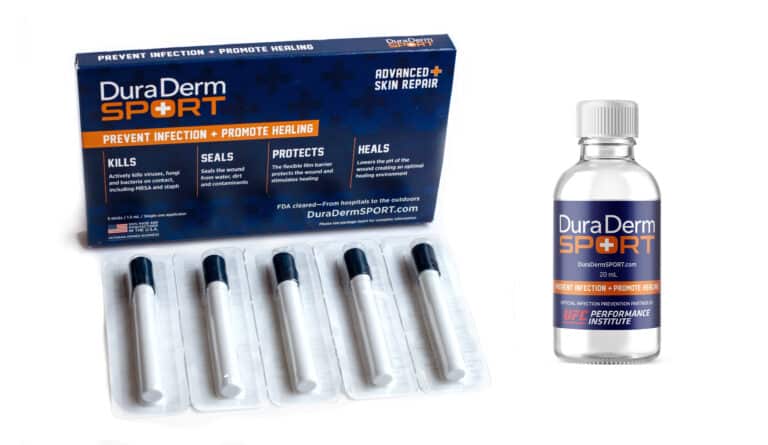
DuraDerm SPORT Duo
Now Available!

DuraDerm® SPORT is a product of Prevent-Plus, LLC © 2024 Prevent-Plus, LLC. All rights reserved.
DuraDerm® SPORT is a FDA cleared Class I medical device. DuraDerm® SPORT is a non-antibiotic, microbicidal liquid polymer that forms a protective film barrier over the skin. WARNING: For use on minor wounds, cuts, abrasions, burns and scrapes that are clean and dry. Not for use on deep, infected, or puncture wounds. Do not use near eyes or mouth.

